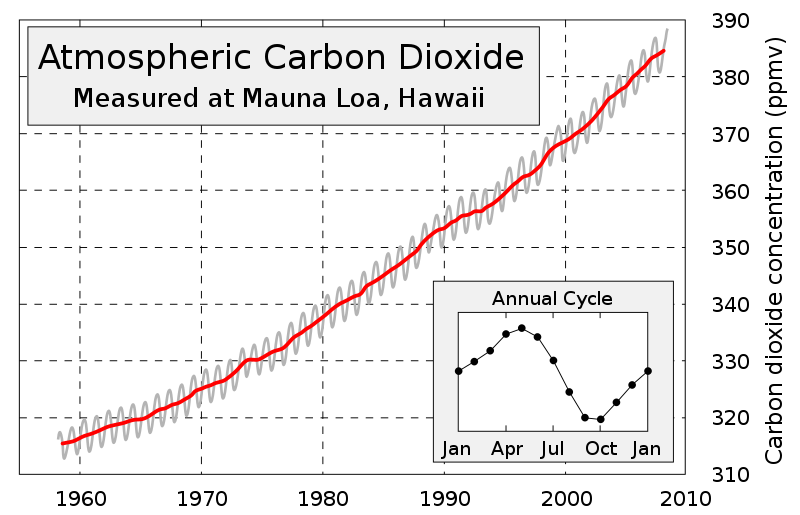Once again we have some mistaken commenters talking about climate change. Can humans be causing it… if it exists at all? Well, we need to see a few things first.
First is the simple fact that, chemically, carbon dioxide blocks the transmission of infrared energy. Here’s a basic description of how this works. Because of the shape and bond lengths of the carbon dioxide molecule, it absorbs electromagnetic radiation at 4,260 nanometers and 14,990 nanometers. This is infrared radiation… also known as ‘heat’.
So, sunlight in the visible spectrum (and IR) hits the earth. Some of that visible light energy is reduced in wavelength to infrared energy and radiated away from the Earth’s surface. Carbon dioxide in the atmosphere absorbs some of that energy and starts vibrating. In turn, that energetic carbon dioxide molecules hits other molecules (nitrogen, for example) and transfers some of that energy to the other molecule.
What is ‘temperature’? In the most basic form, temperature is the measure of the kinetic energy of a group of molecules. It’s like a big microwave oven, except instead of microwaves, the energy comes from infrared. That’s how carbon dioxide (and other gases like methane and water) act as a ‘greenhouse’ and trap heat energy on the Earth.
Anyone who disagrees with this simple fact has some major problems. They are basically disagreeing with all of established chemistry and physics and should not be taken seriously.
Second, this brings up a fairly common complaint from global warming deniers. The complaint is (and I may not have it exactly right), “the amount of carbon dioxide added by man can only account for 5% of the temperature of the Earth”.
That’s an interesting statement because it’s true. If there were no carbon dioxide or other greenhouse gases in the atmosphere, the average temperature of the Earth would be very, very cold. The 20th century average global temperature was approximately 15.5°C (59.9°F). If there were no greenhouse gases, then the average temperature of the Earth would be close to zero degree Fahrenheit.
So, the Earth is livable because of carbon dioxide (and other greenhouse gases) in the atmosphere. But let’s look at what people are actually doing…

So, yes, the Earth goes through massive changes in the CO2 levels. Compare that chart of the last 400,000 years to this chart of the last 50.

In the last 50 years, the CO2 level in the atmosphere has gone from near the maximum reached four times in the 400,000 years (310ppm) to well over 380 ppm.
Now, we know that carbon dioxide increases the temperature of the planet. No doubts about that. We also see, that the average amount of CO2 in the atmosphere is nearly 25% higher than at any point in the last 400,000 years. Where is all that extra carbon dioxide coming from?
Well… it’s coming from us. This isn’t speculation or even a guess based on the number of cars on the road. It’s a very detailed scientific explanation.
To understand why, we need to look at the carbon cycle.

The numbers indicate the amount of carbon either stored in a system (reservoir) or flowing between two systems (i.e. burning of fossil fuels). The numbers are in Gigatons of carbon per year… yes… billions of tons of carbon per year.
If you look closely, you’ll see that most of the flows between the atmosphere and ground/water/etc are fairly close to the same value. For example, respiration (organisms breathing out carbon dioxide) results in 119.6 gigatons of carbon going into the atmosphere every year. But gross primary productivity (i.e. photosynthesis) takes about 120 gigatons of carbon out of the atmosphere each year.
The entire system is delicately balanced… except for that one value over on the right. Fossil fuels don’t have any system in place for taking carbon out of the atmosphere.
We all know that carbon in fossil fuels comes from deep under the ground. Oil, coal, and natural gas formed tens to hundreds of millions of years ago from peat bogs, forests, and swamps. That carbon was removed from the Earth’s carbon cycle millions of years ago. It was buried deep.
And humans, for the last 100 years, have been sucking up all that carbon and converting it into atmospheric carbon dioxide. In just 10 years, we have burned enough fossil fuels to be responsible for full 10% of the entire atmospheric reservoir.
Here’s some slightly more detailed data
Roughly speaking, since 1990, humans are responsible for about 140 gigatons of carbon of the 600 gigatons of carbon in the atmosphere… or roughly 25% of it.
Finally, a brief word about “anomalies”. You will often see “temperature anomalies” instead of actual temperatures used in the literature. I don’t like that because it easily allows for apples to oranges comparisons. If one person is using a 5-year mean and another person is using a 1950-2000 mean as the comparison value, then those two people will arrive at different ‘anomaly’ values.
This has caused no end of confusion, especially in climate denialist circles. I personally prefer straight temperature graphs. I have seen claims that the 1930s where higher temperatures than the last few years. And, when looking at certain data sets, the temperature anomaly is indeed higher. However, a +1.5 degree increase from 58 degrees is still colder than a +1 degree increase from 60 degrees.
Here’s the actual temperatures, courtesy of NOAA.

I hope that helps, let me know of you have questions.
